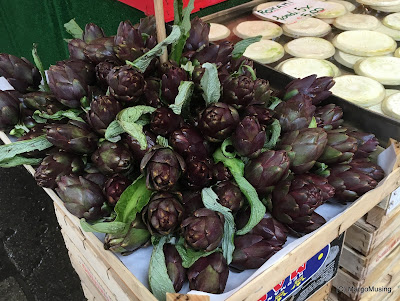My trip to the ferry stop took me via the fruit and fish markets at the Rialto, after which there was a somewhat grey ferry ride to Torcello.
I got an early boat,and there were very few people around as I walked up from the landing stage to the cathedral. There is just one canal, which leads from the ferry quay to the village so you can't get lost, and while the landscape is not very inspiring, it it was good to be away from the city for a little while, and enjoy some peace and greenery.
I had not realised, but there are actually 2 churches, side by side. There is the 11thC church of St Fosca, which is starkly plain and understated inside. I liked it, but there are no mosaics!
 |
| St Fosca |
Then there is the Cathedral of Santa Maria Assunta, which was founded in the 7thC, although the current building was mostly built in the 11thC, with additions and repairs in the 14th
It does have mosaics. And they are very impressive. I was fortunate that when I arrived, there was no one else in the church, so I got to enjoy them in peace for a a short time, before others joined me!
There are images of Mary and of Christ in two of the Domes at the Eastern end of the church, but the really dramatic one is on the West wall, where there is a huge image of Judgement Day.
 |
| Cattedrale di Torcello (Basilica di Santa Maria Assunta) |
On the opposite side, are the damned, being cast into Hell, together with little vignettes illustrating the seven deadly sins, although I am embarrassed to admit that I am not certain which sin is which (Although I'd guess that the 3 people on the left, having a snack while standing in a fire, probably represent Gluttony...)
As well as the church, Torcello also has a tiny historical and archaeological museum, which I visited briefly.
At around this point, a couple of school trips arrived, so I decided to leave.
Back in Venice, and after a rather tasty lunch, I found the Scuola Dalmata - also known as San Giorgio degli Schiavoni. It is one of Venice's mediaval confraternity houses (or Scuolas), and I wanted to go because, in 1502 the members arranged for the painter Carpaccio to paint a series of panels of the fraternity's patron saints, including a rather nice one of St George and the Dragon.
I should mention, perhaps, that I don't know much about medieval art, and next to nothing about Carpaccio, but I saw a picture of this panel and liked it, so I wanted to see the original.
Another panel shows George triumphantly leading the (now much smaller!) dragon into a town square.
Another of the Scuola's parton saints was St Jerome, who apparently struck up a friendship with a lion after removing a thorn from the lion's paw.
The painting shows Jerome with the lion, together with some rather alarmed friars. I'm with the friars on this one. I am not sure that I would wish to rely , for my safety, on the gratitude of a lion...
But I did like the pictures. They have a certain charm to them which appeals to me.
I spent the remainder of the afternoon looking at a different kind of art altogether, one which I think needs its own post.






No comments:
Post a Comment